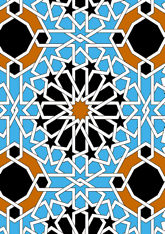Alhambra, Sala de los Ajimeces
 data164/C2
(Click on image for high-quality PDF version)
data164/C2
(Click on image for high-quality PDF version)
From the Sala de los Ajimeces, the long room from the north side of which the Mirador de Lindaraja opens. The pattern here is the middle of three blind windows over the arch leading into the mirador, but is actually on the north wall of the Sala de los Ajimeces.
Geometry
- Growth dynamic build of this pattern.
- Random dynamic build of this pattern.
- Structured dynamic build of this pattern.
- The symmetry group of the tiling is *442 (p4m).
- All the internal angles of the constituent polygons are a multiple of 7.5°.
- Contains one regular two-pointed star polygon with vertex angle of 60°.
- Contains one regular hexagon.
- Contains one regular four-pointed star polygon with vertex angle of 120°.
- Contains one regular 12-pointed star polygon with vertex angle of 60°.
- There are 9 non-regular reflective tiles (including one kite).
- The tiling satisfies the interlace condition and has two finite interlaces and one infinite interlace with straight cross-overs.
- The tiling is edge-to-edge.
- As drawn, contains about 395 polygons.
References
Publications referenced:
- Plate XCIXb (Alhambra, Sala de los Ajimeces, Spain. Blind window from the entrance) of Basilio Pavón Maldonado. El arte hispanomusulman en su decoración geométrica, Madrid : Ministerio de Asuntos Exteriores, Instituto Hispano-Arabe de Cultura, 1975. ISBN 846006881. [pavon] {461p, 140 plates}(1354-91AD, 755-93AH)
- Page 27, Fig 1.35 (Alcazar, Seville, Spain) of Eric Broug. Islamic Geometric Design, Thames and Hudson, 2013. ISBN 978050051695. [broug2] {Many excellent photos}(1616AD, 1025AH)
v54

